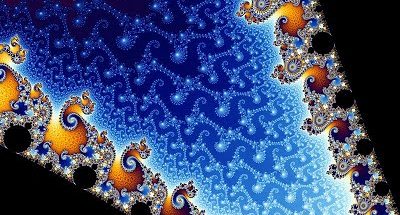In this article, the topics of both the Mandelbrot set and Julia set fractals will be explored. Algorithms involving complex numbers can generate both of these fractals. For example, the set can be generated by the algorithm of:
![]() The sequence starts with a complex number “c”. To see if this number is contained in the Mandelbrot set, one iterates the function with:
The sequence starts with a complex number “c”. To see if this number is contained in the Mandelbrot set, one iterates the function with:
![]()
If the magnitude of the generated number reaches a magnitude of 2 or over, it has been proven that this number will eventually blow up to infinity and this number is, therefore, not in the Mandelbrot set. If the sequence never blows up to infinity then it is part of the Mandelbrot set. This algorithm creates the image of the Mandelbrot set in the complex plane where inputs are complex numbers of the form
![]()
For example:

Since the iterations eventually become greater than 2, this number is not in the Mandelbrot set, where i is the square root of -1. The complex plane is the plane in which real numbers lie on the x-axis and the pure imaginaries lie on the y-axis. This yields the following mesmerizing fractal.

Surprisingly, all of the complex numbers that comprise the Mandelbrot set are contained within the circle of radius two centered at the origin (z=0).
By shading points, according to how fast they diverge to infinity, many beautiful patterns can be created from the Mandelbrot set.


Another similar family of fractals is the Julia sets. Surprisingly, the generating algorithm for Julia sets is exactly the same as that of the Mandelbrot set. The difference is that, instead of varying the “c” value to be equal to the number we are testing, we choose a set c value and only vary the z value. This creates many different types of Julia sets, unlike the one member of the Mandelbrot set. Here is one example of determining whether a Julia Set for c=-0.52 + 0.57.

It turns out that Julia sets fall into two different categories, filled sets, and Cantor sets. A filled set is a Julia set like the one above and as you can see there are clear regions where all points in the Julia set are connected by the black coloring. In cantor sets, the points in the Julia set are not connected and are sometimes referred to as dust.

It turns out that whether or not a Julia set is filled or not depends on if the complex number z=0 is contained within that set. Interestingly, the shape of a Julia Set can be predicted by looking at the corresponding point in the Mandelbrot set for its c value.

The world of fractals is incredibly impressive and complex and many of the fractals themselves are simply mesmerizing with their infinite detail and intricacy. I hope you enjoyed this issue of Mathematical Marvel’s and hope that you will stay tuned for next weeks special Pi Day edition article.








Be First to Comment